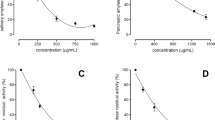Abstract
Purpose. To explore the usefulness of fruit extracts as enhancers of the oral absorption of esterase-sensitive prodrugs.
Methods. Inhibition of esterase-mediated degradation by nature-identical fruit extracts was evaluated using 1) p-nitrophenylacetate (model substrate for esterase-activity) in rat intestinal homogenates and 2) bis(isopropyloxycarbonyloxymethyl)-(R)-9-[(2-phosphonomethoxy) propyl]adenine [bis(POC)-PMPA] (esterase-sensitive prodrug of the antiviral agent PMPA) in Caco-2 cell homogenates and in intestinal homogenates from rat, pig and man. Subsequently, transport of the ester prodrug was studied across Caco-2 monolayers in the presence or absence of fruit extracts.
Results. In homogenates from rat ileum, the esterase activity could be reduced significantly by the inclusion of fruit extracts (1%): the initial enzymatic degradation of p-nitrophenylacetate was inhibited by 77% (strawberry), 16% (passion fruit) and 57% (banana). A similar inhibition of bis(POC)-PMPA metabolism by fruit extracts was observed in intestinal homogenates from several species and in homogenates from Caco-2 cells. Transport of total PMPA across Caco-2 monolayers was enhanced 3-fold by co-incubation with strawberry extract (1%). The fraction of intact prodrug appearing in the acceptor compartment increased from virtually zero to 67%.
Conclusions. The results suggest that co-incubation with nature-identical fruit extracts might be useful as a strategy to enhance the transepithelial transport of esterase-sensitive prodrugs through inhibition of intracellular metabolism of the prodrug.
Similar content being viewed by others
REFERENCES
J. Balzarini, T. Vahlenkamp, H. Egberink, K. Hartmann, M. Witvrouw, C. Pannecouque, P. Casara, J.-F. Navé, and E. De Clercq. Antiretroviral activities of acyclic nucleoside phosphonates [(9-(2-phosphonomethoxyethyl)adenine, 9-(2-phosphonomethoxyethyl)-guanine, (R)-9-(2-phosphonomethoxypropyl)adenine, and MDL 74,968] in cell cultures and murine sarcoma virus-infected newborn NMRI mice. Antimicrob. Agents Chemother. 41:611–616 (1997).
J.-P. Shaw, C. M. Sueoka, R. Oliyai, W. A. Lee, M. N. Arimilli, C. U. Kim, and K. C. Cundy. Metabolism and pharmacokinetics of novel oral prodrugs of 9-[(R)-2-phosphonomethoxypropyl]adenine (PMPA) in dogs. Pharm. Res. 14:1824–1829 (1997).
L. Naesens, N. Bischofberger, P. Augustijns, P. Annaert, G. Van den Mooter, M. N. Arimilli, C. U. Kim, and E. De Clercq. Antiretroviral efficacy and pharmacokinetics of oral bis(isopropyloxycarbonyloxymethyl)-9-(2-phosphonylmethoxypropyl)adenine in mice. Antimicrob. Agents Chemother. 42:1568–1573 (1998).
P. Annaert, R. Kinget, L. Naesens, E. De Clercq, and P. Augustijns. Transport, uptake and metabolism of the bis(pivaloyloxymethyl)-ester prodrug of 9-(2-phosphonomethoxyethyl) adenine in an in vitro cell culture system of the intestinal mucosa (Caco-2). Pharm. Res. 14:492–496 (1997).
C. H. Walker and M. I. Mackness. Esterases: problems of identification and classification. Biochem. Pharmacol. 32:3265–3269 (1983).
M. Gratzl, W. Nastainczyk, and D. Schwab. The spatial arrangement of esterases in the microsomal membrane. Cytobiologie 11:123–132 (1975).
F. M. Williams. Clinical significance of esterases in man. Clin. Pharmacokin. 10:392–403 (1985).
H. M. J. Leng and J. A. Syce. Characterization of pulmonary alveolar esterases of the primate cercopithecus pygerythrus. Pharm. Res. 14:203–207 (1997).
D. G. Bailey, J. D. Spence, C. Munoz, and J. M. O. Arnold. Interaction of citrus juices with felodipine and nifedipine. Lancet 337:268–269 (1991).
Y. Yoshigae, T. Imai, A. Horita, H. Matsukane, and M. Otagiri. Species difference in stereoselective hydrolase activity in intestinal mucosa. Pharm. Res. 15:626–631 (1998).
I. J. Hidalgo, T. J. Raub, and R. T. Borchardt. Characterisation of the man colon carcinoma cell line (Caco-2) as a model system for intestinal epithelial permeability. Gastroenterology 96:736–749 (1989).
P. Augustijns, P. Annaert, P. Heylen, G. Van den Mooter, and R. Kinget. Drug absorption studies of prodrug esters using the Caco-2 model: evaluation of ester hydrolysis and transepithelial transport. Int. J. Pharm. 166:45–53 (1998).
O. H. Lowry, N. J. Rosebrough, A. L. Farr, and R. J. Randall. Protein measurement with the folin phenol reagent. J. Biol. Chem. 193:265–275 (1951).
M. Inoue, M. Morikawa, M. Tsuboi, Y. Ito, and M. Sugiura. Comparative study of human intestinal and hepatic esterases as related to enzymatic properties and hydrolyzing activity for ester-type drugs. Jpn. J. Pharmacol. 30:529–535 (1980).
N. Mignet. Recherche de nouveaux groupements bioréversibles pour masquer les charges internucleosidiques des oligonucleotides antisens. Etude de l'environnement du phosphore internucleosidique le plus adapté à l'approche pro-oligonucleotide. Doctoral thesis, Université Montpellier II, Sciences et Techniques du Languedoc, France, 1996.
Author information
Authors and Affiliations
Corresponding author
Rights and permissions
About this article
Cite this article
Van Gelder, J., Annaert, P., Naesens, L. et al. Inhibition of Intestinal Metabolism of the Antiviral Ester Prodrug bis(POC)-PMPA by Nature-Identical Fruit Extracts as a Strategy to Enhance Its Oral Absorption: An In Vitro Study. Pharm Res 16, 1035–1040 (1999). https://doi.org/10.1023/A:1018931631912
Issue Date:
DOI: https://doi.org/10.1023/A:1018931631912




